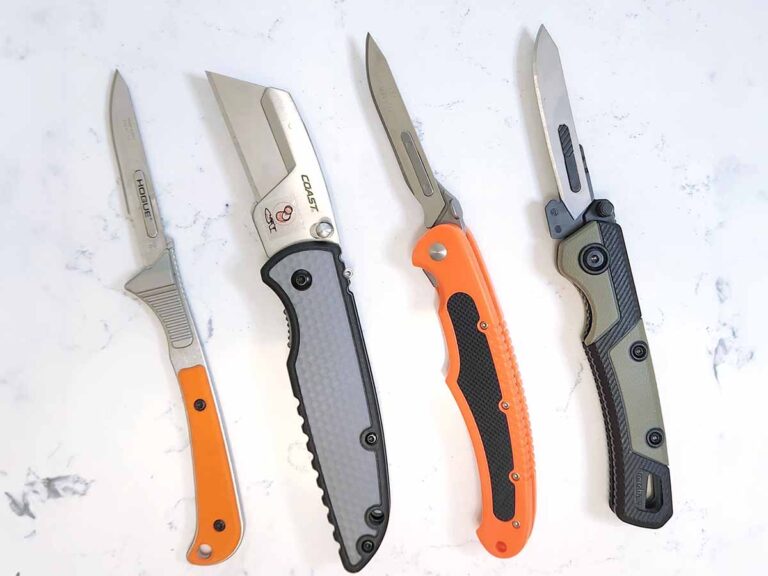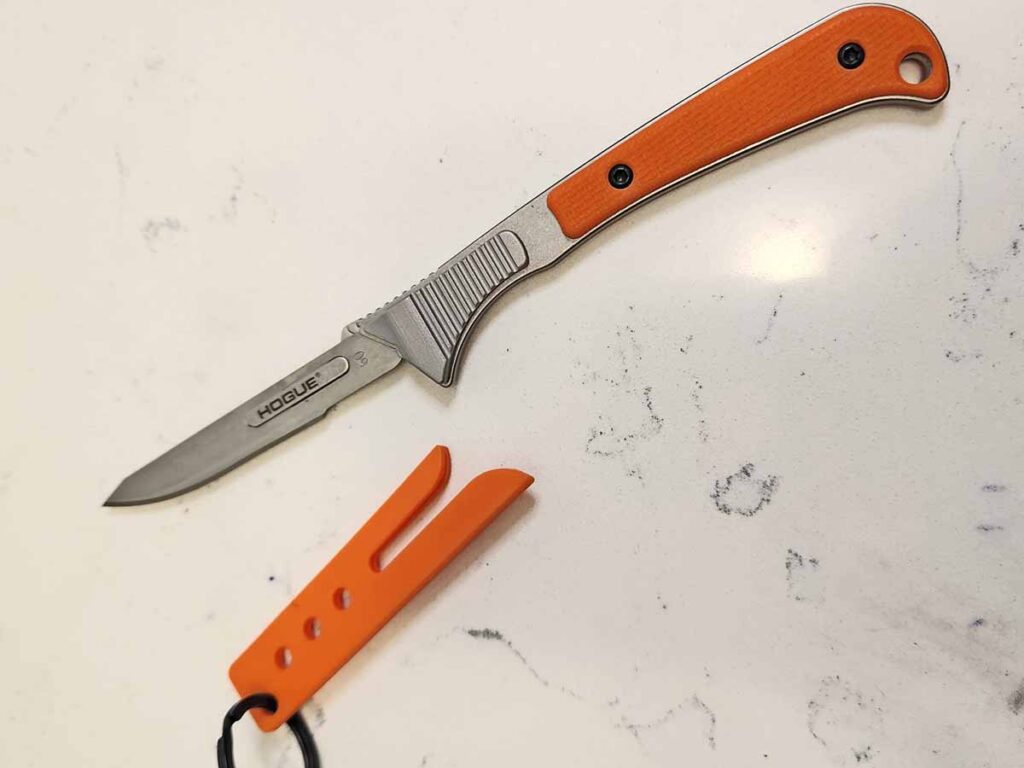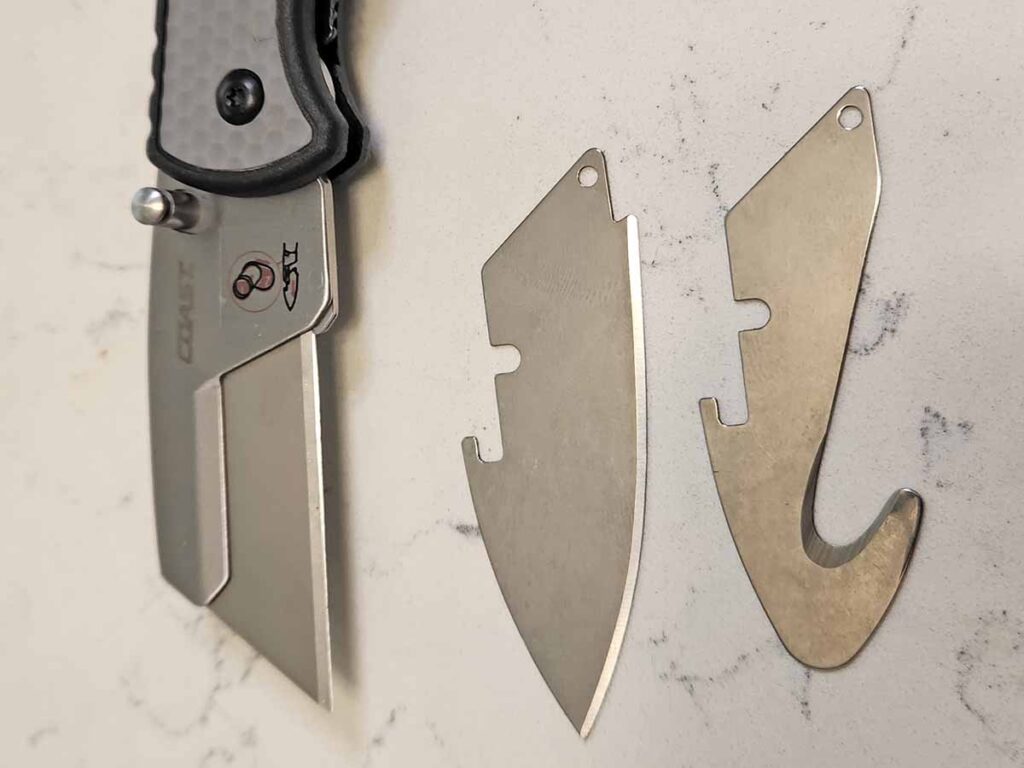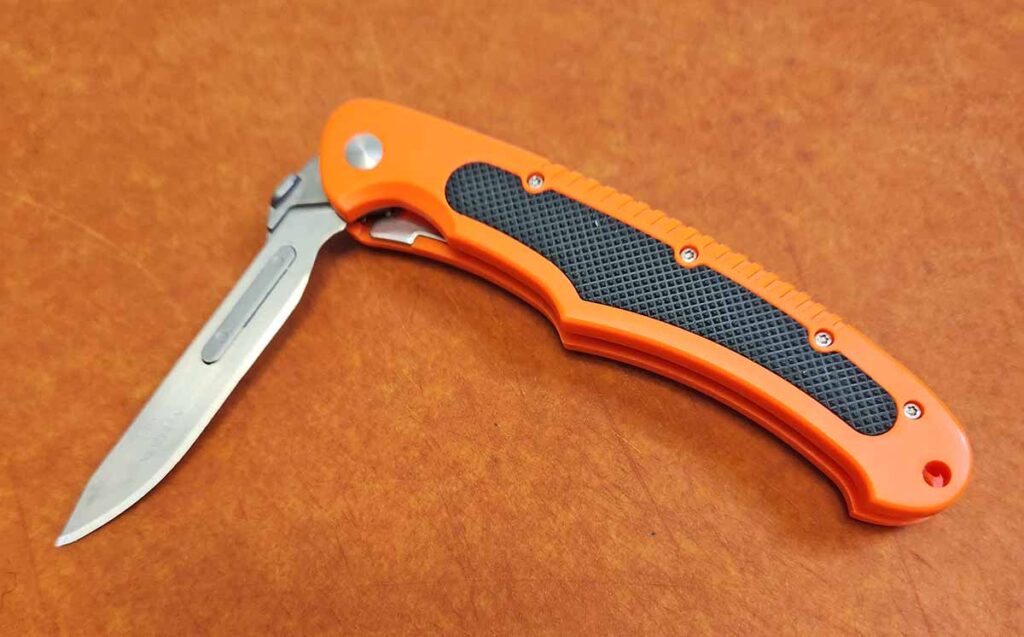
In the field, these knives always help you keep your edge.
And now for a style of edged tool that brings its own brand of controversy most wherever it goes—the replaceable-blade knife. No, not the utility knives you see in a ton of kitchen junk drawers, tradesman’s tool bags and on garage workbenches, but the models made for hunting and possible EDC use.
The controversy tends to surface between the traditional knife-carrying crowd and those who appreciate convenience. As one who loves and teaches sharpening, I tend to leave the replacement blades for my utility knives. These days, however, they have made their way into many different knife styles.
I’m going to gauge how four of the latest replacement models cut and handle, and, most importantly in my mind, how easy it is to change a blade on each one.
Hogue Expel Scalpel 2.5

Right off the bat, you will notice the Hogue Expel Scalpel 2.5 is some serious gear. The handle is a steel tang construction with textured G-10 scales in a blaze orange. The front bolster area is gimped, complete with a thumb ramp. Though the bolsters are screwed on the thumb ramp is not reversible, so sorry to all you southpaws out there. The handle is American made but the blade is marked England and #60. A #60 scalpel is used in dental surgery and postmortem work (it’s nice to know medical examiners wait for the person to expire before they start hacking into them with such a scalpel). Instead of stainless the blade is a high carbon steel. If you want to prolong the life of the Expel’s replacement blade, you can easily strop it.
Since it is an actual scalpel blade, that means you should be able to source multiples of them easy enough. I would go online and order. Since the pattern is used for postmortem work, that would raise fewer eyebrows. I did a quick check and was able to find a pack of 20 of the blades for around $10.
Hogue’s design for its replaceable blade knife uses the traditional blade mounting system. The best way to change the blade is with a pair of pliers. Doctors usually use a set of forceps. Handling wise the knife is quick and nimble. You hold it like a regular scalpel, with your index finger along the blade spine, and guide the edge. It comes with a zipped pouch and a plastic sleeve that fits over the blade. Having the textured G-10 scales and beefier handle contour enhances purchase. I like the design. It fits my hand well. I had perfect control over the edge. I wouldn’t hesitate to take this with me hunting and use it as a caping knife. I certainly will be packing it for pheasant hunting this fall to process the birds and clean up the gizzards.
Hogue Expel Scalpel 2.5 Specs
Overall Length: 7″
Closed Length: Not applicable
Blade Length: 2.5″
Handle material: Orange G-10
MSRP: $114.95
Coast 1919 Reserve Shift

With the 1919 Reserve Shift, Coast has gone with more of a traditional utility folder design. Don’t let that fool you, though, because the knife does offer some innovations. Coast has patented both the blade changing arrangement—called the swap out system—as well as the blade storage system. Two of the three blade styles that come with the knife are customized: the spear tip and gut hook. The third is a regular utility pattern. The system is compatible with standard utility blades, which means you can buy other patterns such as serrated and a roofer’s hooked blades. I don’t know why the company bothered designing a gut hook, as a hooked utility blade would work just as well. The handle is a glass reinforced nylon with a textured rubber insert. The 1919 carries in a pouch sheath.
There are two locking systems. The primary is a linerlock and a double lock prevents the liner from moving to the side. A thumb stud provides ambidextrous one-hand opening. The stud is also part of the opening system. Depress the button on the stud, slide the stud down and the blade comes out.
The blade release system works well but, as far as innovation goes, it doesn’t draw a “wow” from me. Conversely, that Coast bothered to care about how easy it is for you to access the extra blade storage is impressive. It is a straightforward arrangement but, after all, what good is a replaceable-blade system if you can’t get at the extra blades?
Overall, the knife handles like any other utility folder, but the devil is in the details. All the little extras help it edge out the other similar designs. Best of all, except for the proprietary blades, you can pretty much walk into a Walmart and get a blade for the 1919.
Coast 1919 Reserve Shift Specs
Overall Length: 6.875″
Closed Length: 4.375″
Blade Length: 2.5″
Handle material: Glass reinforced nylon w/textured rubber inlay
MSRP: $39.99
Havalon Piranta Bolt

The Havalon Piranta Bolt is a blend between the Coast 1919 and the Hogue Expel Scalpel. The Bolt uses a #60 surgical blade like the Expel Scalpel, though Havalon’s is marked 60A and listed as stainless steel. The blade opens via an ambidextrous thumb disc and locks via a linerlock like the 1919.
A belt carry case houses 12 extra blades. If you only occasionally stropped your blades instead of changing them out, you would have a ton of cutting time. The handle is a bright orange ABS plastic with a textured rubber insert. It feels blocky in the hand. Using ABS plastic keeps the knife lightweight. Between the lightweight feel of the plastic and the lack of contouring, it is not a comfortable grip. The small, trim-profile pocket clip is stronger than it looks.
Havalon gets innovative as far as providing a blade-replacing tool. When changing a scalpel blade, normally you take a set of forceps or a pliers and lift up the back end and push the blade forward. Havalon’s little clamshell-style tool closes around the blade so the edge is not exposed. Snap the tool closed and the rear of the blade bends upward, enabling you to pull the blade off the holder. It worked every time I tried it and it didn’t damage the blade. I was even able to reinstall the same blade. An issue is that there is no place to store the tool in the pouch and, due to its size, would be easy to misplace/lose.
Havalon Piranta Bolt Specs
Overall Length: 7.375″
Closed Length: 4.5″
Blade Length: 2.75″
Handle material: ABS plastic w/rubber inlay
MSRP: $54.99
Kershaw LoneRock RBK 2

The Kershaw LoneRock RBK 2 is another replaceable model that uses a #60 scalpel blade. (I’m starting to feel like a few of these companies had a meeting and I wasn’t invited.) The RBK 2 comes with 14 extra blades in a carry case and one on the knife. A pocket in the belt pouch holds the carry case. A cool feature of the case is a slash pocket for the knife, making it easier to get a purchase on the handle for deployment.
Speaking of the handle, it’s glass filled nylon with rubber overlay. It’s listed as black and tan but looks more like black and green. If I had to pick something Kershaw should have had more foresight about, it’s the color. Green and black pretty much screams “lose me” for a hunting knife. On the other hand, for caping the #60 scalpel blades should do the trick. Also, Kershaw did a great job contouring the handle so it’s easy and comfortable to hold. The blade opens ambidextrously via the double thumb stud and secures via a linerlock. There is no pocket clip, though there is a hole for a lanyard.
Kershaw really put its thinking cap on when it comes to tool-less blade removal. A liner lifts the rear of the scalpel blade, enabling you to slide the blade off. However, I would still play it safe and grab the blade with, say, a pair of pliers. During use I never had an issue with the removal liner being bumped, but I will wait and see. I must say, Kershaw impressed me with this one.
Kershaw LoneRock RBK 2 Specs
Overall Length: 7.2″
Closed Length: 4.4″
Blade Length: 2.8″
Handle material: Glass filled nylon w/rubber overlay
MSRP: $47.99
Points To Ponder
Replaceable-blade knives add to the depth of edged tools available in the cutlery world. As with all knives, they have their place. They have already experienced some popularity among certain trades and professions. If you like to sharpen, remember that even a replaceable blade can be touched up at times.
Check Out More Outdoor Knives And Tools:
- Best Bushcraft Knife: When Steel Meets Woods
- Best Camp Knives: Outdoor Do-Alls
- Best Hatchets And Axes For Survival And Camping
- Best Gut Hook Hunting Knives
 NEXT STEP: Download Your Free KNIFE GUIDE Issue of BLADE Magazine
NEXT STEP: Download Your Free KNIFE GUIDE Issue of BLADE Magazine
BLADE’s annual Knife Guide Issue features the newest knives and sharpeners, plus knife and axe reviews, knife sheaths, kit knives and a Knife Industry Directory.Get your FREE digital PDF instant download of the annual Knife Guide. No, really! We will email it to you right now when you subscribe to the BLADE email newsletter.






